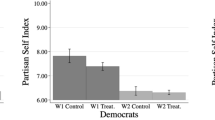Abstract
Using data from the UK General Election Surveys of 1983 and 1987, we present a critical test of different approaches to tactical voting. Specifically, we are concerned with how the competitive situation in each constituency affects voters' likelihood of voting tactically, as well as the role of voters' attitudes and personal characteristics. We find that voters are less sensitive to the actual marginality of a district than to whether or not their party has a chance of winning the seat. In addition, we find that party identification, and particularly intense loyalty, dampen the tendency to vote tactically, regardless of the type of district. We also consider differences in tactical voting between constituencies where Labour dominates vs. districts where the Conservatives are strongest. Finally, we discuss the broader implications of these findings for the study of voting behavior.
Similar content being viewed by others
References
Abramowitz, A. I., Lanoue D. J., and Ramesh, S. (1988). Economic conditions, casual attributions, and political evaluations in the 1984 presidential election.Journal of Politics 50: 848–863.
Aldrich, J. H., and Nelson, F. D. (1984).Linear Probability, Logit, and Probit Models. Beverly Hills, CA: Sage Publishing Company.
Black, J. H. (1978). The multicandidate calculus of voting: Applications to Canadian federal elections.American Journal of Political Science 22: 609–638.
Bloom, H. S., and Price, H. D. (1975). Voter response to short-run economic conditions: The asymmetric effect of prosperity and recession.American Political Science Review 69: 1240–1254.
Butler, D., and Kavanagh, D. (1984).The British General Election of 1983. New York: St Martin's Press.
Cain, B. E. (1978). Strategic voting in Britain.American Journal of Political Science 22: 639–655.
Catt, H. (1989). Tactical voting in Britain.Parliamentary Affairs 42: 548–559.
Derbyshire, I. (1988).Politics in Britain: From Callaghan to Thatcher. Cambridge: Cambridge University Press.
Downs, A. (1957).An Economic Theory of Democracy. New York: Harper & Row.
Fishman, N., and Shaw, A. (1989). TV87: The campaign to make tactical voting make votes count. In I. Crewe and M. Harrop (eds.),Political Communication: The General Election Campaign of 1987. Cambridge: Cambridge University Press.
Kernell, S. (1977). Presidential popularity and negative voting: An alternative explanation of the midterm congressional decline of the president's party.American Political Science Review 71: 44–66.
Kinder, D. R., and Kiewiet, D. R. (1979). Economic grievances and political behavior: The role of personal discontents and collective judgments in congressional voting.American Journal of Political Science 23: 495–527.
Niemi, R. G., Whitten, G., and Franklin, M. N. (1991). Constituency characteristics, individual characteristics, and tactical voting in the 1987 British general election. Paper presented at the 1991 meeting of the American Political Science Association, Washington, D.C.
Rasmussen, J. (1984). The alliance campaign, watersheds, and landslides: Was 1983 a fault line in British politics? In A. Ranney (ed.),Britain at the Polls 1983: A Study of the General Election. Durham, NC: Duke University Press.
Thomas, M., ed. (1983).The BBC Guide to Parliament. London: BBC.
Tsebelis, G. (1986). A general model of tactical and inverse tactical voting.British Journal of Political Science 16: 395–404.
Wolfinger, R. E., and Rosenstone, S. J. (1980).Who Votes? New Haven, CT: Yale University Press.
Author information
Authors and Affiliations
Rights and permissions
About this article
Cite this article
Lanoue, D.J., Bowler, S. The sources of tactical voting in British parliamentary elections, 1983–1987. Polit Behav 14, 141–157 (1992). https://doi.org/10.1007/BF00992239
Issue Date:
DOI: https://doi.org/10.1007/BF00992239




